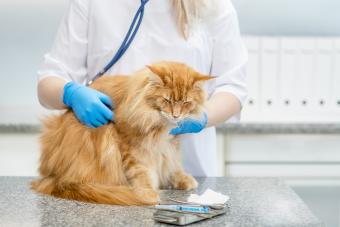
With the chilly air and gusty winds, winter brings a mix of snowy fun and some new things to keep in mind for our cool cats. Frostbite is one of those sneaky concerns, especially when our cats are enjoying the winter wonderland, whether on a leash in the backyard or doing their in-and-out dance in the catio. So, let's review when to keep an eye out for frostbite and how we can wrap our furry friends in some extra warmth. Because in this winter tale, our furballs' safety takes center stage.
Yes, Cats Can Get Frostbite
Frostbite happens when your cat's body, trying to shield its vital organs from the cold, redirects blood flow away from their extremities. This protective mechanism means less blood — and therefore less warmth — reaches parts like their ears, paws, noses, and tails. This can mean serious damage to these parts of their body.
How Fast Can Cats Get Frostbite?
Frostbite can happen fast in cats, especially in blizzards or frigid winter conditions. How quickly it happens depends on how cold and windy it is and if the cat is young, old, unhealthy, or has thin fur. In super-cold weather, a cat's ears, paws, and tail can get frostbite in just a few minutes. Cats are at a higher risk when it's below freezing (32°F or 0°C). Wind makes it worse by pulling more heat away from their body.
Frostbite damage can take a few days to fully show. Prevention is key to help your cat's ears, toes and other extremities stay safe.

Mild Signs of Frostbite in Cats
Early stages of frostbite are less severe, and there's a good chance that the areas can heal with proper warming methods. It's important to gently warm these areas, perhaps with warm (not hot) water or blankets, but avoid rubbing or massaging them, as this can cause damage. Signs of mild frostbite include but aren't limited to:
- Affected areas will feel notably cold when you touch them
- Might even have a bluish tint
If you think your cat may have frostbite, it's important to also seek veterinary care immediately. Your veterinarian can help you decide on the best course of treatment and check for any underlying issues that might have contributed to the frostbite. Early intervention can significantly increase the chances of a full recovery for your cat.
Neighborhood cats with missing ear-tips likely aren't frostbite victims but rather part of a trap-neuter-release program for feral cats. Find out what to do if you find a stray cat.
Severe Signs of Frostbite in Cats
In cases of severe frostbite in cats, the affected areas will not only be bluish but may also start turning black, indicating the death of tissue in those regions. At this advanced stage, the damage is often irreparable, and the tissue is typically beyond recovery. This severity of frostbite may require stronger medical intervention, like amputation, to prevent potentially fatal complications.
There are other instances where the affected area is small and less critical, like the tip of an ear. In these kinds of cases, your veterinarian might decide to let it heal naturally under close observation. In these kinds of scenarios, it's common to eventually see the dead portion of the tissue come off on its own.
It's crucial to follow the veterinarian's advice and care instructions meticulously in cases of frostbite to ensure the best possible outcome for your cat. Your veterinarian will help you to monitor for any signs of infection or other complications during the healing process.
Are Some Cats More Prone to Frostbite?

All cats are more likely to get frostbite in cold, wet, and windy weather. Young kittens, older cats, and those with health problems have a higher risk of getting frostbite in any cold weather. Short-haired cats are also at a higher risk than long-haired cats. A Maine coon cat, for example, is more likely to withstand the cold temperatures than an American shorthair cat.
It's important to note that no cat, regardless of breed or fur length, should be left outside on their own during the winter. Providing a warm and safe environment for all cats, even ferals, during the colder months is crucial to preventing frostbite and ensuring their overall well-being.
Your Veterinarian is Your Best Resource
If you have any suspicion that your cat might be suffering from frostbite, even if you don't think it's that bad, you should seek professional veterinary care as soon as possible. There could still be dangers you're unaware of. While you prepare to visit the vet, keep your cat in a dry and warm environment to help gradually increase their body temperature. This can be done by placing them in a cozy area away from cold drafts. If your cat is shivering, a dry towel or blanket can be used to gently wrap them, providing additional warmth and comfort.
Refrain from touching frostbitten areas to avoid causing additional irritation. It's important not to use direct heat sources like hot water bottles or heating pads. They can cause burns, especially on frostbitten skin. Bringing your kitty to the vet to check on your cat is really important. They can figure out how bad the frostbite is, give the right treatments, and tell you how to care for your cat to help them get better.
What Can You Do to Prevent Frostbite in Cats?
The simple rule of thumb is that if the weather is too chilly for you, it's also too cold for your cat. To protect your feline friends from frostbite and other winter dangers, it's best to keep them indoors during the colder months (and the other months, too, if possible, as indoor kitties tend to be much safer).
If they need some fresh air, you can let them out into a secure catio or take them for a walk on a leash. This way, they can safely enjoy the outdoors without being exposed to the harsh elements, wildlife, and other hazards in their environment. And be especially cautious during times of extreme cold or when the wind is particularly strong, as these conditions can be dangerous for both you and your cat.
Keeping Your Kitty Inside
Dealing with a cat like mine, who's always looking for an escape to the outdoors, can be quite a challenge, especially when they're so determined to explore. It's tough to resist their adorable cat eyes while they're asking to go play outside, but keeping them safe from dangerous situations like frostbite is crucial. My cat, Llyod recently decided he wanted to check out the outdoor life, so we've been working on ways to enrich his indoor life and reduce boredom.
Creating a catio is definitely on my to-do list to provide him with a safe outdoor experience. In the meantime, giving him access to window perches is a great alternative. These perches allow him to enjoy the outdoor scenery from the warmth and safety of indoors. It's important to remember that while our cats may love the outdoors, our priority should be their safety and well-being, especially in extreme weather conditions.







